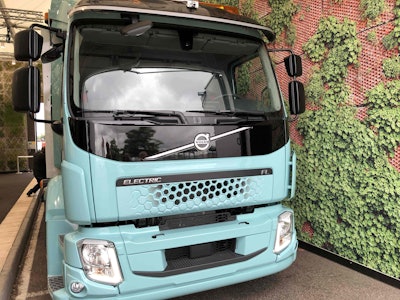
Several weeks after Volvo Trucks debuted its first two electric trucks for the European trade press in Sweden, it was the North American journalists’ turn to experience the company’s new fully electric FL and FE models.
And it’s appropriate that European media had the first turn, since these trucks undoubtedly will find a home in regional and urban environments throughout Scandinavia and Europe before the North American market identifies suitable applications for Volvo’s battery technology in Volvo Trucks’ truck lineup in North America.
The Volvo FL and FE conventional cabovers are the smallest models in the truck maker’s global product mix. The units are used primarily for city distribution, waste hauling, light construction and utility work — all perfect applications for electrification.
The 5- or 8-liter engines and I-Shift transmissions on Volvo’s diesel-powered FL and FE models are replaced with an all-new electric driveline and a Volvo two-speed transmission. The two-axle FL Electric is paired with a 185-kW motor capable of producing 248 hp and 313 lb.-ft. torque, and the three-axle FE Electric gets double the power with two electric motors totaling 370 kW, 496 hp and 627 lb.-ft. torque.
The electric motors are powered by 50-kWh lithium-ion batteries weighing in at 236 pounds each. Both the FE and FL can be equipped with up to six batteries for a range of 300 km (186 miles) depending on the duty cycle.
“If you have 300 kW of batteries on the vehicle, it will take you 10 to 12 hours to recharge to full load,” said Edward Jobson, chief engineer for Volvo Trucks’ electric project.
The FE and FL Electric trucks will be commercially available in 2019 starting in the European markets. “We are evaluating the entire world and markets [for electric trucks],” said Magnus Koeck, vice president of marketing and brand management for Volvo Trucks North America. “Eventually we will test these in North America with dates yet to be decided. It needs to make business sense and will start in these [light-duty] applications but we believe this technology is here to stay.”
First impressions
A day after taking Volvo Truck’s diesel-powered FL for a spin around the company’s test track in Gothenburg, Sweden, I had the opportunity to climb in to the FL Electric for a brief two-mile test drive. (The FE Electric model unfortunately wasn’t available as it was being shipped to the Hague on the western coast of the Netherlands ahead of the finale of the Volvo Ocean Race.)
Outside of a few “Electric” badge plates on the side of the truck, the two models are identical to the eye.
To the ear, however, the trucks are completely different. Turning the ignition key in the FL Electric generates an indicator light to let the operator know the vehicle is on. If you listen hard – and I mean really, really hard – you can hear the faintest whir of the electric motor.
Aside from the lack of sound, pressing the accelerator reveals the other truly distinct characteristic of the FL Electric over a conventional diesel truck: torque.
“Combustion is completely stupid!,” my Swedish ride supervisor said gleefully as we zoomed away from the ElectriCity outdoor display at the Volvo Ocean Race stopover event. As it turns out, the FL Electric delivers a seemingly flat torque curve, so stepping into acceleration the same way I did the diesel FL resulted in a surprising and satisfyingly fast launch.
The electric drivetrain generously provides ample power when asked, although we never were able to get above 45 kmph on our driven outside the fairgrounds. Letting off the accelerator slows the truck without braking, so instead of coasting as you would in a diesel truck you have to “feather” the pedal to maintain a constant speed.
This article was written by Jeff Crissey, editor of Commercial Carrier Journal, a partner publication of Hard Working Trucks.








